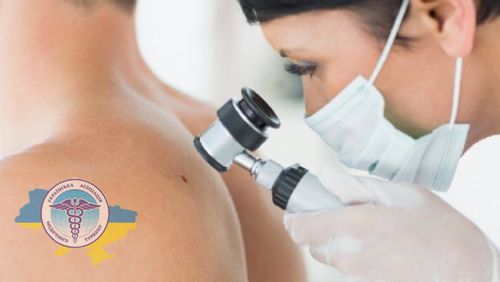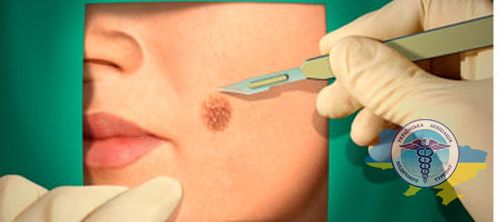Treatment of melanoma in German clinics

Melanoma (skin cancer) is one of the most aggressive oncological diseases, prone to rapid progression and metastasis, which significantly worsens the prognosis for the patient. Therefore, early diagnosis of melanoma is extremely important: at the initial stage, when the tumor is localized in the epidermis, the probability of obtaining a positive result reaches 100%.
When treating melanoma in Germany, one of the lowest mortality rates in the world is achieved - only about 1.3%, and the prognosis for 5-year survival with a tumor thickness of up to 1 mm without metastases is more than 90%. This is ensured by the highest diagnostic accuracy - even with a visual examination by German oncologists it reaches 90%, which is confirmed by histological examination.

Want to know how much the treatment costs?
Answer a few questions and get preliminary information about the cost of diagnosis and treatment!
Advantages of melanoma treatment in Germany
By going to Germany for skin cancer treatment, patients receive many benefits:
- Individual approach to surgery planning. German oncology surgeons carefully study diagnostic data in order to plan the most optimal amount of surgical intervention for each individual patient. This allows you to remove the tumor as much as possible while preserving as much healthy tissue as possible.
- Carrying out organ-preserving operations. If melanoma is localized on the face, hands, feet and other cosmetically significant areas, German surgeons try to preserve organs and tissues as much as possible, removing only the tumor itself. This avoids disfigurement and disability of patients.
- Refusal of lymph node dissection. Preventive removal of lymph nodes for melanoma is associated with a high risk of complications - lymphostasis, lymphorrhea, infection. Therefore, when treating melanoma in German clinics, a biopsy of the sentinel lymph node is required, and lymph node dissection is performed only when metastases are confirmed.
- Reconstructive operations with skin grafting. After melanoma resection, German plastic surgeons can close the tissue defect using a skin flap transplant. This allows you to restore the skin and the aesthetic appearance of the operated area.
- Modern surgical techniques. In Germany, gentle operations with minimal distance from the edges of the tumor are used, for example, Mohs micrographic surgery. In this case, each section along the resection edge is immediately examined by a pathologist to identify tumor remnants.
- Minimally invasive therapy. In addition to surgical treatment, modern antitumor drugs (targeted, immunotherapy), radiation therapy, and laser destruction are used in Germany. This allows you to achieve good results even with advanced forms of melanoma.
How is melanoma diagnosed in German clinics?

Diagnosis of melanoma in Germany begins with a thorough medical history, examination of the skin and suspicious formations. The ABCDE algorithm is used to identify characteristic signs of a tumor.
After a visual examination, doctors prescribe the following studies:
- Dermatoscopy. A non-invasive method for visualizing skin tumors with high (10-100 times) magnification. Allows you to identify characteristic signs of melanoma: asymmetry of structure, uneven borders, different colors, the presence of dots and spots.
- Cytological examination. It involves taking cells from the surface of the tumor and studying them under a microscope, during which characteristic atypical cells containing pigment are identified.
- Histology of tumor biopsy. During the procedure, the level of invasion according to Clark (how deep the tumor has penetrated), the thickness of the tumor according to Breslow, as well as mitotic activity are determined.
- Visualization. Using ultrasound, CT and MRI machines, doctors can detect metastases in regional lymph nodes, as well as in distant organs and tissues, even in the early stages.
- Sentinel lymph node biopsy. Using a special dye, the primary lymph node is determined, where lymph flows from the affected area. Its study makes it possible to detect even single cancer cells.
- Confocal laser microscopy. Makes it possible to obtain a high-resolution three-dimensional image of the structure of melanoma without the need for a biopsy. Laser scanning with computer data processing is used, which in some cases allows surgical intervention to be avoided.
- Biopsy. Complete excision of the tumor and histological examination are performed to confirm its malignancy and characteristics.
- Lymph node biopsy. If the diagnosis of melanoma is confirmed and metastasis is suspected, surgical removal of the lymph nodes is performed, followed by histological examination to verify the lesion.
Melanoma treatment methods in German clinics

For the treatment of melanoma, German clinics use an integrated approach using modern progressive techniques. The choice of tactics is based on the location and stage of the disease, the presence or absence of metastases. Typically used:
Surgical intervention
The optimal treatment for melanoma in the early stages is surgical excision of the tumor within the visible boundaries of the lesion. The goal is complete removal of malignant cells to prevent relapse. Unfortunately, most patients present with an already advanced process when surgical options are limited.
Skin excision
The standard surgical treatment for melanoma is excision of the tumor with an indentation within apparently healthy tissue. The extent of resection depends on the size and location of the affected tissue.
An important component is a sentinel lymph node biopsy using a radioactive tag. This allows you to identify the primary affected lymph node and avoid traumatic removal of a large number of lymph nodes in the absence of metastases.
In rare cases, melanoma of the extremities may require amputation of the affected segment to prevent progression of the tumor process.
Operation Mohs
When melanoma is localized in cosmetically or functionally significant areas, organ-preserving Mohs surgery is used. It consists of step-by-step excision of the tumor in thin layers with simultaneous histological examination of the resection edges.
The operation continues until clean resection margins are obtained along the entire perimeter. This allows you to preserve healthy tissues and organs as much as possible. This method requires a significant amount of time, but is gentle and effective.
Conservative therapy
Conservative methods play a supporting role in the complex treatment of melanoma. They are used in addition to surgery to reduce the risk of recurrence and progression, and to relieve symptoms in metastatic disease.
Radiation therapy
Radiation therapy in Germany is carried out strictly according to indications, using modern equipment to maximize the preservation of healthy tissue. Irradiation is rarely used, mainly in the following cases:
- To minimize pain during metastases to the bones, brain, and other organs.
- In the treatment of brain tumors.
- For the prevention of relapses after surgical treatment of cancer.
- For removal of regional metastases.
- If the operation is impossible.
Radiation therapy in German oncology centers is carried out on an outpatient basis, the course ranges from 5 to 30 sessions. The duration of the procedure is from 5 to 30 minutes. Side effects are minimal thanks to the use of modern techniques.
Targeted therapy
This is a modern direction based on influencing molecular targets in cancer cells. Typically, the following medications are used:
- BRAF inhibitors (vemurafenib, dabrafenib) - for BRAF V600 mutation. Effective for 40-50% of patients.
- MEK inhibitors (trametinib, cobimetinib) - in combination with BRAF inhibitors increase the duration of response.
- KIT inhibitors (imatinib) - for KIT mutations. Effective for 16-29% of patients.
The indication for targeted therapy is the presence of mutations in the tumor, determined by molecular genetic testing. Drug treatment is carried out on an outpatient basis, and the course lasts from 6 to 12 months.
Immunotherapy
One of the most promising methods used in cancer centers in Germany. It is based on stimulation of the immune system’s own antitumor mechanisms. Immunotherapy can significantly increase life expectancy when metastases appear, as well as slow down the growth of cancer cells.
The highest quality results are shown by:
- Administration of interferon drugs to activate the immune system.
- Monoclonal antibodies that block immune checkpoints. They relieve the inhibitory effect of cancer on immune cells.
- Vaccine therapy using dendritic cells.
- Passive administration of activated T lymphocytes.
Chemotherapy
Plays a limited role in the treatment of melanoma, being inferior in effectiveness to other methods of medical intervention. Systemic chemotherapy is practically not used in the adjuvant mode.
However, in some cases, when the tumor is localized on the extremities, isolated chemoperfusion is used - the introduction of chemotherapy drugs directly into the vessels of the affected arm or leg. This method can be used if surgery is not possible.
Innovative techniques
In Germany, advanced methods of treating skin cancer are used. Some of them show such effectiveness that they make it possible to achieve remission even in the most severe forms of the disease. The most popular of them:
- Oncolytic viral therapy. It is used when surgical intervention is not possible. The drug talimogene laherparvovec (T-VEC) is administered intratumorally once every 14 days, and as a result, stabilization of the affected area or reduction in its size is obtained.
- Tumor-infiltrating lymphocyte (TIL) therapy. The method involves isolating immune cells from tumor samples and then cloning them. After this, the most cytotoxic clones are selected, re-cultured to 30-50 million cells and administered to the patient. The technique allows to achieve a complete response in 20% and a partial response in 30% of patients.
- Photodynamic therapy. Sometimes it can even be used instead of surgery. Preferable when localized in cosmetically significant areas. A photosensitizer is introduced into the patient's body, which accumulates in cancer cells. Then local laser irradiation is carried out, which triggers a photochemical destruction reaction. This method provides survival similar to surgery, but at the same time shows a much better cosmetic effect.
- Stereotactic radiosurgery. Allows you to deliver a dose of ionizing radiation directly to the tumor lesion with high precision, minimizing the radiation dose to surrounding healthy tissue. Narrow beams of radiation generated by linear accelerators or a gamma knife are used. Due to the high precision of radiation, stereotactic radiosurgery is especially effective for the treatment of melanoma of the brain, as well as individual metastases in other organs.
- Cryodestruction. Used to remove superficial metastases. Liquid nitrogen is injected into the lesion through special cryoapplicators under high pressure, causing rapid local freezing of tissue to a temperature of -1960C. This leads to necrosis and death of the neoplasm. This intervention can be performed on an outpatient basis and under local anesthesia. There is no blood loss during the process, and wounds heal very quickly.
Cost of treatment for melanoma in Germany
In order to give you an estimated price for melanoma treatment in Germany, provide our specialist with medical documentation. Based on this, the receiving German clinic will draw up a preliminary treatment plan and provide an estimate.
The final amount depends on the histological form, location of the disease, the degree of invasion into surrounding tissues and the presence of metastases.
The average cost for popular procedures is shown in the table:
| Procedure | Cost, € |
|---|---|
| Standard examination | from 2300 |
| Biopsy of a neoplasm | from 620 |
| Resection and biopsy of sentinel lymph nodes | from 5600 |
| Histological examination | from 1500 |
| Surgical removal of stage 1 tumor | from 3200 |
| Consultation with oncodermatologist | from 320 |
| Biopsy of lymph nodes in the hospital | from 7300 |
| Chemotherapy course | from 3000 |
It should be noted that prices in German medical institutions are approximately 30-50% lower than in US clinics. At the same time, the quality of services and effectiveness are quite comparable.



